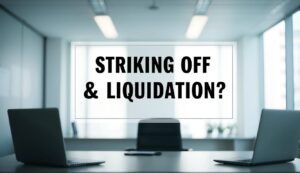What’s the Difference Between Striking Off a Company and Liquidation?
When closing your company, you have two main options: striking off or liquidation. These processes serve different purposes and have distinct requirements. Striking off is suitable for companies without outstanding debts or legal issues. The process takes about three months, during which your intent to strike off is advertised in The Gazette. A liquidation required a licensed insolvency practitioner.
Key Takeaways
- Striking off is for debt-free companies and costs £10
- Liquidation is necessary for insolvent businesses and starts at £3,000 typically
- You must not attempt to strike off if you have a Bounce Back Loan
Key Differences Between Striking Off and Liquidation
When closing your company, you have two main options: striking off and liquidation. These processes serve different purposes and suit distinct circumstances.
Striking off is a straightforward method for companies without debts or those able to clear all debts before closure. You can pursue this route if your business hasn’t traded for three months, hasn’t changed its name recently, and faces no insolvency proceedings or legal issues.
To strike off your company, you’ll need to complete a DS1 form on Companies House. The closure will be advertised in The Gazette. If no objections arise within three months, your company will be removed from the register.
Liquidation, specifically a creditors’ voluntary liquidation, is necessary when your company is insolvent and unable to pay debts. This process requires an insolvency practitioner and is more complex and costly.
Here’s a quick comparison:
Aspect |
Striking Off |
Liquidation |
| Cost: | £10 | From £3,000 + VAT |
| Suitable for: | Debt-free companies | Insolvent companies |
| Process: | Simple form filing | Complex, involves insolvency practitioner |
| Timeframe: | 3 months (if no objections) | Varies, often longer |
If you have debts, striking off is not the appropriate path. You must go through the insolvency process. In rare cases where you have no assets, no director redundancy claim, and no Bounce Back Loan, you might consider striking off. However, you must inform creditors and HMRC of your intentions.
Remember, if you’ve taken a Bounce Back Loan, attempting to strike off your company is not allowed.
Book a free consultation today [/fusion_button]

Criteria for Striking Off a Company
You can strike off your company under specific circumstances. This process is suitable when your business has no outstanding debts or can settle all liabilities before initiating the strike-off procedure.
To be eligible for striking off, your company must meet several criteria:
- No trading activity in the past three months
- No name changes in the last three months
- No ongoing insolvency proceedings
- All creditors paid in full
- No pending legal issues
Striking off and liquidation – what’s the difference? Striking off is for solvent companies, while liquidation is typically for insolvent businesses that cannot pay their debts when due. Liquidation requires the services of an insolvency practitioner and can cost upwards of £3,000 plus VAT for small companies.
You must not attempt to strike off your company if you have outstanding debts. This includes Bounce Back Loans. If you’re unable to pay your debts but have no assets or cash in the business, you may consider writing to your creditors and HMRC to explain your situation. They might allow the strike-off to proceed, but this approach carries risks and should be carefully considered.
Closing Down Your Company
Filling Out the DS01 Form
To strike off your company, you’ll need to complete a DS01 form on Companies House. Before proceeding, ensure your business meets the following criteria:
- Not traded for the past 3 months
- Not changed its name in the last 3 months
- No ongoing insolvency proceedings
- All debts paid in full
- No outstanding legal issues
If your company meets these requirements, you can proceed with the strike-off application.
Publication in The Gazette
After submitting the DS01 form, your company’s strike-off notice will be advertised in The Gazette. This is the official journal of public record for the UK. If you’re based in England or Wales, it will appear in the London Gazette. For Scottish companies, it will be published in The Edinburgh Gazette.
The notice will remain in The Gazette for 3 months. During this period, any interested parties can object to the strike-off. If no objections are raised within this timeframe, your company will be removed from the Companies House register.
Remember, if your company has outstanding debts or has taken out a Bounce Back Loan, you must not attempt to strike it off. In these cases, you’ll need to pursue a formal insolvency process, such as liquidation, which requires the involvement of a licensed insolvency practitioner.
Free Consultation – advice@andersonbrookes.co.uk or call on 0800 1804 935 our freephone number (including from mobiles).
Winding Up a Company
Company Voluntary Liquidation Explained
When your business becomes insolvent and can’t pay its debts, you might need to consider a company voluntary liquidation. This formal process involves appointing an insolvency practitioner to close your company. It’s a more complex and costly procedure than simply striking off a company, with fees starting from £3,000 plus VAT for smaller businesses.
During liquidation, the insolvency practitioner will handle all aspects of closing your company, including selling assets, settling debts where possible, and dealing with creditors. This process ensures a proper closure when your company can’t meet its financial obligations.
It’s crucial to note that if your company has outstanding debts, you mustn’t attempt to strike it off. Liquidation is the appropriate route in these circumstances. However, if you have no assets, no cash, and haven’t taken out a Bounce Back Loan, you might consider writing to creditors and HMRC explaining your situation before attempting to strike off the company.
Remember, if you’ve taken a Bounce Back Loan, striking off your company is not an option. You must go through the proper liquidation process to ensure all legal obligations are met.
Financial Considerations
Fees for Striking Off vs Winding Up
When closing your company, you have two main options: striking off or liquidation. The costs associated with each process differ significantly.
Striking off is the more affordable choice, while a liquidation, specifically a creditors’ voluntary liquidation, is can be more expensive. This process is necessary if your company is insolvent and unable to pay its debts. You’ll need to hire an insolvency practitioner to manage the closure formally.
It’s crucial to choose the appropriate method based on your company’s financial situation. If you have debts, striking off is not the proper course of action. However, in rare cases where you have no assets, no cash, and haven’t taken out a Bounce Back Loan, you might consider striking off even with debts. In this scenario, you must inform HMRC and your creditors of your intentions.
Remember, if you’ve taken a Bounce Back Loan, striking off is not an option. You must proceed with liquidation to ensure all legal obligations are met.
Handling Insolvency
When your company faces financial difficulties and has debts it may mean a option 2, is your best option – this is a liquidation. Specifically a creditors’ voluntary liquidation, is necessary when your company is insolvent and unable to pay debts as they fall due. This process requires hiring an insolvency practitioner.
If you have debts, striking off is not the appropriate method. However, in rare cases where you have no assets, no cash, and haven’t taken a Bounce Back Loan, you might attempt to strike off. You must inform your creditors and HMRC in writing, explaining your situation and offering them the option to liquidate the company themselves.
Be aware that if you’ve taken a Bounce Back Loan, striking off is not permitted. Always consult with a professional to ensure you’re following the correct procedure for your specific circumstances.
When to Seek Help from an Insolvency Expert
If your company is facing financial difficulties, it’s important to know when to consult an insolvency practitioner. You should seek professional advice if your business can’t pay its debts when they’re due. This situation is known as insolvency.
Insolvency practitioners, such as Anderson Brookes, are essential when considering a creditors’ voluntary liquidation. This process is appropriate when your company has significant debts and no realistic prospect of recovery. Unlike striking off, which is for solvent companies, liquidation is a formal procedure for insolvent businesses.
You’ll need an insolvency practitioner if:
- Your company has substantial unpaid debts
- Creditors are threatening legal action
- You’ve exhausted all options to turn the business around
- There are outstanding legal issues related to the company
The cost of liquidation typically starts from £3,000 plus VAT for small companies. While this may seem steep, it’s the proper route if your company is insolvent. We have a full article on CVL Costs.
If you’ve taken out a Bounce Back Loan, you must not attempt to strike off your company. In this case, consulting an insolvency practitioner is crucial to ensure you’re following the correct legal procedures.
Remember, attempting to strike off an insolvent company without addressing its debts is not advisable and can lead to serious consequences. Always seek professional advice if you’re unsure about your company’s financial position or the best course of action.
Exceptions to Standard Company Closure Procedures
When You Have No Assets and No Bounce Back Loan
In certain circumstances, you might find yourself in a unique situation where standard company closure procedures may not be applicable. If your business has no assets, no cash, and crucially, you haven’t taken out a Bounce Back Loan, you might have a potential alternative to formal liquidation.
Should you find yourself in this position and unable to afford the costs associated with liquidation, you may consider attempting a strike-off. However, it’s vital to approach this carefully and ethically.
Here’s what you should do:
- Write to your creditors, including HM Revenue & Customs (HMRC)
- Explain your financial situation clearly
- State that you have no cash or assets in the business
- Invite them to liquidate the company themselves if they wish
- Mention that you intend to strike off the company if no action is taken
It’s likely that if there are truly no assets to recover, HMRC and other creditors may allow the strike-off to proceed. This approach can save you the significant costs associated with formal liquidation.
Remember:
- This is only applicable if you have not taken a Bounce Back Loan
- You must be transparent with all creditors
- It’s important to act in good faith and not attempt to hide any assets
Always seek professional advice before proceeding with any company closure method to ensure you’re acting within the law and meeting all your obligations as a director.
Legal Obligations to Creditors
When closing your company, you must carefully consider your legal obligations to creditors. If your business has no outstanding debts, you may opt for striking off. This process involves submitting a DS1 form to Companies House and paying a £10 fee. The strike-off is then advertised in The Gazette, and if no objections arise within three months, your company is removed from the register.
However, if your company is insolvent and unable to pay its debts, you must pursue liquidation. This requires appointing an insolvency practitioner, such as Anderson Brookes.
In rare cases where you have no assets, cash, or director redundancy claims, and importantly, no Bounce Back Loan, you might consider striking off despite having debts. In this scenario, you must inform your creditors and HM Revenue & Customs (HMRC) in writing about your situation. Explain that you lack funds and assets, but invite them to liquidate the company if they wish. HMRC may allow the strike-off to proceed if they see no value in liquidation.
Remember, if you’ve taken a Bounce Back Loan, striking off is not an option. You must follow proper insolvency procedures to ensure you meet all legal obligations to your creditors.
Striking Off & Liquidation: Key Points
If you’re considering closing your company, hopefully this article has helped you further understand the differences differences striking off and liquidation. Striking off is suitable for businesses without debts or those able to clear all debts beforehand. You can pursue this option if your company hasn’t traded or changed its name in the past three months, faces no insolvency proceedings or legal issues, and has settled all creditor debts.
Liquidation, specifically a creditors‘ voluntary liquidation, is necessary when your company is insolvent and unable to pay debts as they fall due.
If you’re struggling financially but haven’t taken a Bounce Back Loan, you might consider striking off. However, you must inform creditors and HMRC in writing about your situation. Remember, if you’ve received a Bounce Back Loan, striking off is not an option.
For further questions, please leave a comment below. If you’re watching on YouTube, don’t forget to subscribe to the channel. You can reach out to Chris Wen for additional guidance.
Anderson Brookes – Google Reviews

&





